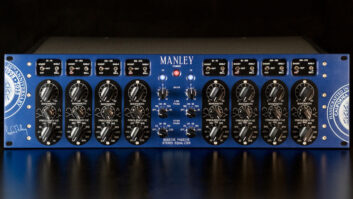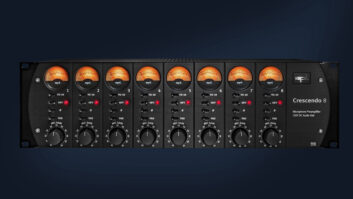There are lots of equalizers on the market. So, does the world really need another EQ? Having heard Manley Labs’ Massive Passive, I can answer with a resounding “Yes!”
The Massive Passive is a 2-channel, 4-band parametric design with lowpass and highpass filters. I/Os are balanced XLR and TRS operating at +4 dBu, with DIP switches for changing levels to -10 dBv, a first for any Manley product.
Each of the four EQ bands has a +/-20dB gain range with a switch having illuminated cut/boost indicators and center bypass position, rotary switch with 11 center frequencies, continuously variable bandwidth (“Q”) control, and a shelf/bell switch. The front panel also has the six-position (Off plus five switchable frequencies) lowpass and highpass filters, two gain trim pots, illuminated bypass switches for both channels, and a power switch with a 20-second warm-up delay.
The front panel seems simple, with a few caveats: The gain controls are zeroed (flat) at the full CCW position, rather than the “12 o’clock = 0 dB” configuration of a typical EQ. The bypass switches are not true hard-wired bypass, but disengage the filter and tube gain make-up stages while leaving the input amp and output transformer in-circuit. The unit uses true passive equalization and has its bands connected in parallel (rather than the series approach used in nearly all other EQs), so there is a high degree of interaction between the bands, especially in the gain and bandwidth controls. Therefore, a true correlation between the gain control position and any exact number of dB change is unlikely. For example, the full 20dB cut/boost range is only available in Shelf mode at a wide bandwidth; at narrower settings, gain drops to +/-12 dB, and the opposite is true in the bell curve setting-the +/-20dB max is only available at the narrow settings.
Fortunately, EQ is more about what sounds best than it is a matter of exact settings. And this is where the Massive Passive really shines. The goal of designer “Hutch” Hutchison was to create a mastering-quality EQ that had the curves of Pultec’s EQP-1A and HP/LP filters (but offering much wider ranges), with the sound of vintage Neve and API EQs. And in an era when op amp-based equalizers are the norm, the Massive Passive keeps to its name, with true passive equalization, based on huge, real inductors, custom-wound at the Manley factory. The parametric EQ center frequencies were chosen for musicality, rather than numeric ISO centers.
In session, I was tracking drums with a pair of Neumann M147s on overheads, and Audix D4 on kick and electronic snare (fed from an Alesis DM Pro drum module). The M147s provided a punchy, full sound with a nice balance of toms and cymbals-and only needed a little extra top sizzle. A touch of Massive Passive shelving at 18 kHz added the perfect amount of sheen.
Tracking with a CAD VX2 tube mic on background voices, I was looking for an ethereal quality-lots of air, a huge presence boost and a rolled-off bottom, so the Massive Passive came into use as an effect, with a radical 220Hz highpass filter, a narrow-band boost at 4.7 kHz and a wide shelf boost at 27 kHz. Here, the EQ’s boost/cut/bypass switches on each band were invaluable in getting the right sound fast, while the gain trim pots allow the flat vs. EQ settings to play at exactly the same level for accurate A/B comparisons.
In mixing pop tracks, the Massive Passive was wonderful on all kinds of tracks: horns, acoustic and electric guitar, percussion and, of course, vocals, offering the versatility to be as subtle or as in-your-face as you want. But the unit is equally suitable in mastering applications. Working on a premastering session with British guitarist/songwriter Anthony Hindson, on the title track to his It’s a Curious Life CD (Wind in Hare Records), a blend of top Western and Indian musicians, we wanted to tweak up some Shankar violin fills (without becoming shrill or stepping on Jack Bruce’s vocals), and a narrow 2.2kHz bump did the trick. At the same time, we added a 68Hz shelf boost for more fullness to Jack’s bass, slipped in a narrow 390Hz cut to reduce mush and added a bit of 27kHz shelving for the “ahh!” factor.
With its innovative circuit design, feature set, stunning audio clarity and its sound, the Massive Passive is clearly in a league of its own. Retailing at $4,800, it ain’t exactly pocket change, though, so refinance your house, and get several for your rack. You won’t regret it.
Manley Laboratories, 13880 Magnolia Ave, Chino, CA 91710; 909/627-4256; fax: 909/628/2482; www.manleylabs.com.







